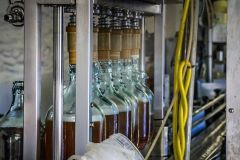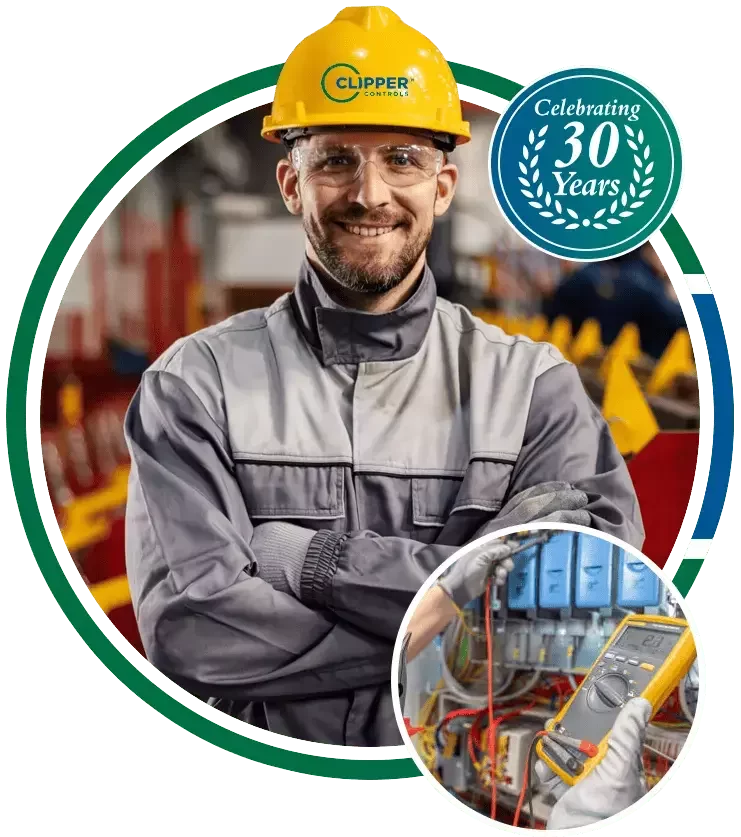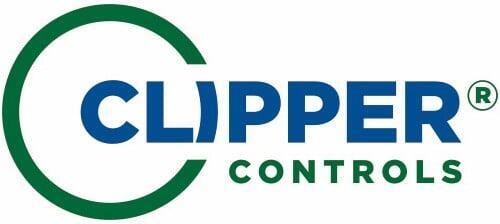Food and Beverage Process Control Applications

Quick Page Navigation:
🔹How Our Products Support Your Industry
Pressure & Temperature Regulation
Hygienic and Sanitary Process Control
Gas Detection & Environmental Monitoring
Industrial Automation & Data Integration
🔹Industry Standards & Regulatory Compliance
🔹Benefits of Working With Clipper Controls
Application Overview
Food and beverage process control applications require precise monitoring and automation to ensure product consistency, safety, and regulatory compliance. From raw material intake to final packaging, every stage of production depends on accurate measurement and control of variables such as temperature, pressure, flow, level, and composition. Maintaining these parameters within tight tolerances not only optimizes efficiency but also minimizes waste, reduces downtime, and ensures adherence to industry standards like FDA, USDA, and HACCP regulations. Advanced instrumentation and control systems play a critical role in achieving repeatable, high-quality results while integrating seamlessly with plant-wide automation and data management systems.
Modern food and beverage facilities demand real-time data acquisition and intelligent process control to support operational agility and traceability. As batch and continuous processing methods evolve, manufacturers must implement robust solutions for mixing, blending, pasteurization, fermentation, and clean-in-place (CIP) systems. The integration of smart sensors, industrial networking, and process analytics enhances visibility into production performance, enabling predictive maintenance and energy efficiency improvements. With growing industry emphasis on sustainability, hygienic design, and digital transformation, precise process control is essential for meeting consumer expectations and regulatory demands while maintaining operational excellence.
How Our Products Support Your Industry
Key Applications and Solutions
Flow Measurement & Control
Accurate flow measurement is essential for maintaining quality, efficiency, and regulatory compliance in food and beverage processing. Whether managing ingredient mixing, ensuring precise dosing, or optimizing Clean-in-Place (CIP) operations, flow meters play a critical role in maintaining consistency and reducing waste. From monitoring the flow of water, milk, syrups, and juices to measuring high-viscosity materials like sauces and oils, selecting the right flow measurement technology enhances production control and minimizes downtime.
Applications of Flow Measurement in Food & Beverage
Flow meters are used across a wide range of food and beverage applications to ensure precise control over liquid and gas movement throughout production. Key applications and related products include:
- Ingredient Dosing & Blending – Electromagnetic and Coriolis flow meters help ensure accurate measurement of liquid ingredients, syrups, and flavorings, maintaining product consistency.
- Carbonation Control – Thermal mass and Coriolis flow meters regulate CO₂ flow in soft drinks and beer to achieve precise carbonation levels.
- Dairy Processing – Hygienic electromagnetic flow meters monitor milk and cream flow for pasteurization and separation while meeting 3A sanitary standards.
- CIP (Clean-in-Place) Systems – Ultrasonic and magnetic flow meters verify the correct flow of cleaning solutions and rinse water, optimizing sanitation and preventing contamination.
- Bottling & Packaging – Positive displacement and turbine flow meters ensure accurate volumetric filling of bottles, cans, and pouches.
- Steam Flow Measurement – Vortex flow meters regulate steam flow in sterilization, cooking, and brewing processes to enhance energy efficiency.
- Wastewater Treatment – Open-channel flow meters and ultrasonic flow meters monitor effluent discharge and water reuse systems, supporting sustainability and environmental compliance.
Key Purchasing Considerations
Selecting the right flow meter for food and beverage applications depends on several critical factors, including hygiene, accuracy, and compatibility with process conditions. Important considerations include:
- Hygienic Design – Flow meters should be constructed with FDA-approved materials such as stainless steel and feature CIP/SIP (Steam-in-Place) compatibility.
- Measurement Technology – Options such as electromagnetic, Coriolis, ultrasonic, and vortex flow meters should be selected based on the type of liquid, viscosity, and presence of particulates.
- Accuracy & Repeatability – High precision and consistent measurement performance are essential to maintaining product quality.
- Integration with Control Systems – Flow meters should be compatible with SCADA, PLC, and industrial automation networks for real-time monitoring and data analysis.
- Environmental Conditions – Consider factors such as temperature fluctuations, pressure variations, and potential exposure to aggressive cleaning agents.
- Flow Range & Scalability – Select a meter that supports the required flow rate while allowing flexibility for future process expansion.
Level Monitoring & Management
Reliable level measurement is essential in food and beverage processing to ensure precise ingredient control, prevent overflows, and optimize storage and production efficiency. Accurate level monitoring helps maintain consistency in batch processing, supports automated dispensing, and ensures compliance with industry regulations. Whether measuring liquid levels in storage tanks, monitoring dry bulk ingredients in silos, or controlling foam buildup in fermentation processes, selecting the right level sensor improves production control and minimizes waste.
Applications of Level Measurement in Food & Beverage
Level measurement is critical for managing inventory, batching, and quality control across various food and beverage production stages. Key applications and related products include:
- Ingredient Storage & Inventory Management – Radar and ultrasonic level sensors monitor bulk ingredient levels in storage tanks and silos, ensuring accurate inventory tracking.
- Mixing & Blending Processes – Capacitive and guided wave radar sensors ensure proper ingredient levels in mixing vessels, maintaining product consistency.
- Dairy Processing & Milk Storage – Non-contact radar and hydrostatic level transmitters provide hygienic and accurate monitoring of milk and cream storage tanks.
- Brewing & Fermentation Control – Pressure-based level sensors and radar sensors help monitor fermentation tank levels while managing foam detection.
- CIP (Clean-in-Place) Systems – Ultrasonic and optical level sensors verify cleaning fluid levels to maintain proper sanitation and prevent process interruptions.
- Dry Bulk Material Handling – Guided wave radar and capacitance probes measure flour, sugar, grains, and powdered ingredients in silos and hoppers.
- Bottling & Packaging – Optical and ultrasonic sensors ensure precise liquid levels in filling lines to maintain consistency across packaged products.
- Wastewater & Effluent Management – Submersible level sensors and radar level meters monitor wastewater levels in treatment systems to support sustainability efforts.
Key Purchasing Considerations
Selecting the right level measurement technology depends on factors such as the type of material being measured, environmental conditions, and integration with process control systems. Important considerations include:
- Hygienic Design – Level sensors should meet FDA and 3A sanitary standards, using stainless steel or food-grade plastic construction for compliance with food safety regulations.
- Measurement Technology – Different level measurement methods, such as radar, ultrasonic, capacitance, and guided wave radar, should be chosen based on the application (liquids vs. dry solids).
- Non-Contact vs. Contact Measurement – Non-contact sensors like radar and ultrasonic are ideal for highly viscous liquids or foamy environments, while guided wave radar and capacitance probes work well for dry materials.
- Accuracy & Sensitivity – High-precision sensors help maintain consistency in ingredient dosing and product formulation.
- Environmental Conditions – Consider factors such as temperature fluctuations, humidity, and exposure to aggressive cleaning agents in CIP processes.
- Integration with Control Systems – Level sensors should be compatible with SCADA, PLC, and automation networks for real-time monitoring and data logging.
- Foam & Turbulence Compensation – Certain level sensors offer advanced signal processing to ensure accurate readings in applications with foam, agitation, or changing product consistency.
Pressure & Temperature Regulation
Precise pressure and temperature regulation are critical in food and beverage processing to maintain product consistency, ensure food safety, and optimize energy efficiency. From cooking and pasteurization to fermentation and sterilization, controlling these variables is essential to achieving the desired taste, texture, and shelf stability. Pressure and temperature sensors play a vital role in automating and monitoring these processes, ensuring compliance with FDA, USDA, and HACCP regulations. Selecting the right instrumentation improves process reliability, minimizes downtime, and enhances product quality.
Applications of Pressure & Temperature Regulation in Food & Beverage
Pressure and temperature sensors are widely used across food and beverage manufacturing to maintain process control and optimize efficiency. Key applications and related products include:
- Pasteurization & Sterilization – RTD temperature sensors and pressure transmitters ensure precise control in dairy, juice, and canned food pasteurization to eliminate harmful bacteria while preserving quality.
- Cooking & Baking Processes – Thermocouples and pressure sensors regulate temperature in ovens, steam kettles, and fryers to maintain consistent cooking conditions.
- Brewing & Fermentation – Digital temperature probes and pressure sensors monitor fermentation tanks, ensuring optimal yeast activity and flavor development in beer, wine, and kombucha production.
- Steam & Boiler Systems – High-temperature pressure transmitters and thermocouples regulate steam generation for cooking, sterilization, and CIP (Clean-in-Place) systems.
- Dairy Processing & Homogenization – Pressure gauges and temperature transmitters help control milk homogenization and pasteurization to maintain quality and safety.
- Cold Storage & Refrigeration – Wireless temperature sensors track conditions in refrigerated storage and transport to prevent spoilage and ensure food safety.
- Bottling & Carbonation Control – Pressure transducers and temperature controllers maintain optimal carbonation levels in soft drinks and sparkling beverages.
- Extrusion & Drying Processes – High-temperature thermocouples and pressure regulators control drying conditions in cereal, snack, and pet food production.
- CIP & SIP Systems – Hygienic pressure sensors and temperature probes ensure proper cleaning and sterilization cycles, preventing contamination and ensuring compliance with food safety standards.
Key Purchasing Considerations
Choosing the right pressure and temperature regulation devices requires consideration of factors such as accuracy, response time, and sanitary design. Key selection criteria include:
- Hygienic & Food-Grade Design – Sensors should meet 3A, FDA, and EHEDG sanitary standards, with stainless steel or food-safe coatings for CIP/SIP compatibility.
- Accuracy & Stability – High-precision pressure and temperature sensors ensure consistent product quality and regulatory compliance.
- Environmental Durability – Instruments should withstand exposure to high temperatures, humidity, cleaning agents, and corrosive environments in food processing plants.
- Non-Contact vs. Contact Sensors – Infrared and wireless sensors provide non-invasive temperature monitoring, while RTDs and thermocouples offer direct contact measurement for more precise control.
- Real-Time Monitoring & Automation – Devices should integrate seamlessly with SCADA, PLC, and industrial automation systems to enable real-time adjustments and predictive maintenance.
- Response Time & Range – Fast-response sensors are essential for dynamic processes like cooking, extrusion, and carbonation, while wide measurement ranges support diverse applications.
- Steam & Pressure Rating – Pressure transmitters must be rated for high-temperature steam environments, especially in pasteurization, sterilization, and CIP applications.
- Wireless & Remote Monitoring Capabilities – IoT-enabled sensors offer enhanced visibility and control over distributed processing systems, reducing manual checks and improving efficiency.
Hygienic and Sanitary Process Control
Maintaining strict hygienic and sanitary standards in food and beverage processing is essential for ensuring product safety, regulatory compliance, and operational efficiency. From ingredient handling to final packaging, every stage of production must adhere to stringent cleanliness requirements to prevent contamination and preserve product quality. Implementing advanced sanitary process control solutions helps manufacturers meet FDA, USDA, and HACCP regulations while optimizing production uptime and reducing risks associated with foodborne pathogens.
Applications of Hygienic and Sanitary Process Control in Food & Beverage
Hygienic and sanitary process control solutions are essential across various food and beverage applications to ensure clean, safe, and high-quality production environments. These solutions are commonly used in:
- Dairy Processing & Pasteurization, where sanitary pressure transmitters, temperature sensors, and flow meters ensure compliance with 3A and EHEDG hygiene standards.
- CIP (Clean-in-Place) & SIP (Steam-in-Place) Systems, where automated cleaning verification sensors confirm proper circulation of cleaning agents to eliminate bacteria and residue.
- Brewing & Beverage Production, where aseptic valves, sanitary pumps, and hygienic flow meters prevent microbial contamination in fermentation and carbonation processes.
- Meat & Poultry Processing, where hygienic level sensors and stainless-steel temperature probes ensure strict control over chilling, cooking, and storage conditions.
- Bakery & Confectionery Manufacturing, where non-contact infrared sensors and hygienic weight monitoring systems ensure ingredient accuracy while maintaining sanitation.
- Pharmaceutical-Grade Food Production, where ultra-hygienic control systems are used for baby formula, nutritional supplements, and medical-grade food processing.
- Cold Storage & Refrigeration, where temperature monitoring sensors and hygienic data logging systems track storage conditions to prevent spoilage.
Key Purchasing Considerations
Selecting the right hygienic and sanitary process control equipment requires attention to regulatory standards, material compatibility, and cleaning efficiency. Important factors to consider when choosing these solutions include:
- Regulatory Compliance, ensuring that all instruments meet FDA, USDA, 3A, and EHEDG hygienic design requirements for food and beverage applications.
- Material Selection, with components made from stainless steel or food-safe plastics that resist corrosion, high temperatures, and aggressive cleaning agents.
- Seamless & Crevice-Free Design, reducing the risk of bacterial buildup by eliminating gaps, weld seams, and rough surfaces in processing equipment.
- CIP/SIP Compatibility, allowing for efficient cleaning without disassembly, ensuring maximum production uptime and minimal risk of cross-contamination.
- Non-Contact & Minimal Intrusion Measurement, using technologies such as ultrasonic, radar, and infrared sensors to minimize product contact and contamination risk.
- High-Temperature & Chemical Resistance, enabling sensors and valves to withstand extreme cleaning cycles, steam sterilization, and harsh sanitization chemicals.
- Automation & Integration Capabilities, ensuring seamless connectivity with SCADA, PLC, and IIoT systems for real-time monitoring and data tracking.
Gas Detection & Environmental Monitoring
Gas detection and environmental monitoring play a crucial role in food and beverage processing by ensuring workplace safety, regulatory compliance, and product integrity. From refrigeration systems to fermentation tanks, gases such as carbon dioxide, ammonia, and methane must be carefully monitored to prevent health hazards, equipment failures, and contamination risks. Proper environmental monitoring also helps maintain optimal air quality, temperature, and humidity levels, which are essential for food preservation, storage, and process efficiency. Implementing advanced gas detection and environmental monitoring systems enhances safety, minimizes operational risks, and supports compliance with OSHA, EPA, and FDA regulations.
Applications of Gas Detection & Environmental Monitoring in Food & Beverage
Gas detection and environmental monitoring are essential across various stages of food and beverage production to ensure safe working conditions, regulatory compliance, and efficient operations. These solutions are commonly used in:
- Refrigeration & Cold Storage Facilities, where ammonia (NH₃) and carbon dioxide (CO₂) gas detectors ensure safe operation of industrial refrigeration systems, preventing leaks and exposure risks.
- Fermentation & Brewing Processes, where CO₂ and oxygen (O₂) sensors monitor gas buildup in fermentation tanks, ensuring worker safety and maintaining precise environmental conditions for yeast activity.
- Modified Atmosphere Packaging (MAP), where gas analyzers check nitrogen (N₂) and carbon dioxide (CO₂) levels in food packaging to extend shelf life and prevent spoilage.
- CIP & Sterilization Systems, where environmental monitoring sensors track airborne chemical residues from cleaning agents such as chlorine dioxide (ClO₂) and peracetic acid (PAA) to ensure worker safety.
- Meat & Poultry Processing Facilities, where hydrogen sulfide (H₂S) and ammonia (NH₃) gas detectors protect workers from exposure to harmful gases released during rendering and refrigeration processes.
- Baking & Milling Operations, where combustible dust monitors detect airborne particulates from flour, sugar, and grain processing, reducing the risk of dust explosions and respiratory hazards.
- Dairy & Cheese Production, where oxygen and temperature sensors maintain controlled environments for aging rooms and storage facilities.
- Wastewater Treatment & Biogas Recovery, where methane (CH₄) and hydrogen sulfide (H₂S) gas sensors monitor emissions from anaerobic digestion and wastewater treatment plants.
Key Purchasing Considerations
Selecting the right gas detection and environmental monitoring equipment requires an understanding of regulatory requirements, sensor accuracy, and integration capabilities. Important factors to consider when choosing these solutions include:
- Regulatory Compliance, ensuring that gas detection systems meet OSHA, EPA, FDA, and FSMA safety standards for workplace air quality and emissions control.
- Sensor Sensitivity & Accuracy, with high-precision gas detectors capable of identifying even low concentrations of hazardous gases to prevent exposure risks.
- Real-Time Monitoring & Alerts, using automated systems that provide instant notifications and alarms for gas leaks, air quality changes, and hazardous conditions.
- Integration with Facility Systems, ensuring that gas detectors and environmental sensors connect with SCADA, PLC, and IIoT networks for seamless data collection and process control.
- Durability & Environmental Resistance, selecting sensors designed for extreme temperatures, high humidity, and exposure to cleaning chemicals common in food processing environments.
- Multi-Gas Detection Capabilities, allowing facilities to monitor multiple gases simultaneously, reducing the need for separate sensors and improving efficiency.
- Wireless & Remote Monitoring Options, enabling continuous tracking of environmental conditions with cloud-based analytics and remote alarm capabilities.
- Maintenance & Calibration Requirements, considering sensor longevity and ease of recalibration to ensure long-term accuracy and reliability in food processing operations.
By implementing advanced gas detection and environmental monitoring systems, food and beverage manufacturers can enhance workplace safety, ensure product quality, and maintain strict regulatory compliance while optimizing operational efficiency.
Industrial Automation & Data Integration
The food and beverage industry increasingly relies on industrial automation and data integration to improve efficiency, reduce waste, and maintain consistent product quality. Smart automation solutions enable precise control over critical processes such as ingredient dosing, cooking, packaging, and quality assurance while reducing reliance on manual operations. With the integration of sensors, programmable logic controllers (PLCs), and supervisory control and data acquisition (SCADA) systems, manufacturers gain real-time visibility into their operations, allowing for predictive maintenance, process optimization, and compliance tracking. Data-driven automation enhances food safety, improves traceability, and ensures consistent production output while minimizing downtime and operational costs.
Applications of Energy Management & Efficiency Solutions in Food & Beverage
Industrial automation and data integration technologies are used throughout food and beverage production to improve process control, efficiency, and compliance. These solutions are commonly applied in:
- Ingredient Dosing & Mixing, where automated batch controllers and flow sensors ensure precise ingredient proportions, reducing human error and improving product consistency.
- Conveyor & Material Handling Systems, where robotic automation and PLCs manage product movement with speed and accuracy, reducing labor costs and enhancing efficiency.
- Quality Control & Inspection, where machine vision systems and AI-powered defect detection help identify inconsistencies in packaging, labeling, and food products.
- CIP (Clean-in-Place) Automation, where integrated control systems optimize cleaning cycles, ensuring compliance with sanitation regulations while minimizing water and chemical usage.
- Real-Time Process Monitoring, where SCADA systems provide real-time visibility into temperature, pressure, and flow conditions to prevent deviations that could affect product quality.
- Predictive Maintenance & Downtime Prevention, where IoT-enabled sensors and AI analytics detect potential equipment failures before they cause production delays.
- Energy Management & Efficiency Monitoring, where smart meters and automation control HVAC, refrigeration, and steam systems to optimize energy usage.
- Track & Trace Compliance, where RFID and barcode scanning systems ensure regulatory compliance by tracing raw materials through the entire supply chain.
- Packaging & Labeling Automation, where high-speed robotics and automated label printers improve accuracy, reduce waste, and speed up production.
Key Purchasing Considerations
Choosing the right industrial automation and data integration solutions requires careful evaluation of compatibility, scalability, and long-term operational benefits. Important considerations include:
- System Compatibility & Integration, ensuring automation components can seamlessly connect with existing PLCs, SCADA systems, and cloud-based analytics platforms.
- Regulatory Compliance & Traceability, selecting systems that meet FDA, FSMA, and HACCP tracking and reporting requirements.
- Scalability & Future Expansion, investing in automation technologies that allow for production growth, equipment upgrades, and evolving process requirements.
- Cybersecurity & Data Protection, implementing secure networks and encrypted data transmission to protect against cyber threats and unauthorized access.
- Ease of Use & Operator Training, ensuring that automation systems have intuitive interfaces and provide comprehensive training programs for operators and maintenance teams.
- Energy Efficiency & Sustainability, considering automation solutions that incorporate energy-saving features, such as demand-driven motors and intelligent power management.
- Real-Time Analytics & Reporting, utilizing AI-powered dashboards and IoT-enabled devices to monitor process performance, reduce waste, and optimize productivity.
- Reliability & Maintenance Needs, selecting automation solutions with robust diagnostics, remote troubleshooting capabilities, and minimal maintenance requirements.
Industry Standards & Regulatory Compliance
FDA, USDA, and GMP Compliance for Food & Beverage Production
FDA Current Good Manufacturing Practices (cGMP – 21 CFR Part 117):
- Requires food facilities to maintain sanitary processing environments, track critical control points, and validate cleaning procedures.
- Mandates real-time monitoring of process conditions, such as cooking temperatures, holding times, and refrigeration parameters.
- Instrumentation must be accurate, reliable, and calibrated regularly to ensure consistent product safety.
USDA Sanitary Inspection Requirements (9 CFR Parts 416 & 430):
- Applicable to meat, poultry, and egg processors, requiring hazard prevention controls and pathogen reduction procedures.
- Requires facilities to implement HACCP-based process monitoring systems and instrumentation that can withstand frequent high-pressure sanitation cycles.
- Enforces the use of stainless steel sensors and hygienic process connections to prevent contamination.
3-A Sanitary Standards:
- Define equipment design criteria for cleanability, material compatibility, and surface finish.
- Applies to flow meters, temperature sensors, level detectors, and control valves used in dairy, beverage, and high-purity applications.
- Ensures that all measurement devices have minimal dead space and are easily sterilizable.
Instrumentation Requirements for Food Safety & Quality Assurance
- High-accuracy RTDs, thermocouples, and pressure sensors ensure proper pasteurization, cooking, and sterilization.
- Instruments must meet sanitary design standards and offer IP67/IP69K-rated enclosures.
- Electromagnetic and Coriolis flow meters support ingredient batching, filling, and CIP verification.
- Non-contact radar and ultrasonic level sensors monitor tank inventory and prevent overflow.
- Inline pH sensors ensure proper fermentation, beverage formulation, and CIP chemical control.
- Conductivity analyzers validate rinse water purity and chemical concentration during cleaning cycles.
- SCADA-connected instruments support real-time alarms, batch reporting, and regulatory recordkeeping.
- Digital validation trails help meet requirements for traceability, recall readiness, and third-party audits.
Environmental & Sustainability Compliance
EPA Clean Water Act & NPDES Permits: Requires monitoring of BOD, TSS, pH, and nutrient levels in effluent streams.
Flow meters and samplers ensure accurate reporting of wastewater volumes and pollutant concentrations.
Energy Efficiency Standards (ISO 50001): Encourages use of instrumentation that supports energy monitoring and optimization, such as compressed air flow meters and power analyzers.
Air Quality Compliance: Facilities with boilers, dryers, or combustion equipment may need to install emissions analyzers for CO₂, NOx, and particulate matter.
Benefits of Working With Clipper Controls
Partnering with Clipper Controls gives food and beverage manufacturers access to expert guidance and precision process control solutions designed for hygienic production. Our high-performance instrumentation ensures seamless integration with existing systems, improving efficiency and reducing downtime. With expertise in flow, level, pressure, and temperature control, Clipper Controls helps maintain product consistency while ensuring compliance with FDA, USDA, and HACCP regulations.
Beyond providing advanced instrumentation, Clipper Controls offers dedicated technical support and application expertise. Our team assists with product selection and system integration, helping manufacturers optimize sanitation, energy efficiency, and regulatory compliance. With durable, high-quality solutions, Clipper Controls enhances operational performance and reliability.
Case Studies & Success Stories
See how we’ve helped food and beverage manufacturers overcome challenges, improve efficiency, and ensure product quality with our expert solutions. From optimizing ingredient dosing to enhancing sanitation processes, our success stories showcase real results and long-term partnerships built on trust and innovation.
Click here to read our food and beverage case studies.

Real Results, Real Impact:
Thanks to Clipper Controls, our wastewater treatment plant improved efficiency & compliance with top-tier flow meters. Reliable solutions, great support! We recommend Clipper Controls to all our partner companies.
~ John Smith, Controls Engineer @ ABC Company
Clipper Controls helped our city upgrade water monitoring systems, ensuring accuracy & compliance. Reliable solutions & excellent customer service!
~ Nancy Patel, Procurement @ ABC Company
~ John Smith, Controls Engineer @ ABC Company
Ready to Work With Us?

Quick Page Navigation:
🔹How Our Products Support Your Industry
Pressure & Temperature Regulation
Hygienic and Sanitary Process Control
Gas Detection & Environmental Monitoring
Industrial Automation & Data Integration
🔹Industry Standards & Regulatory Compliance
🔹Benefits of Working With Clipper Controls


